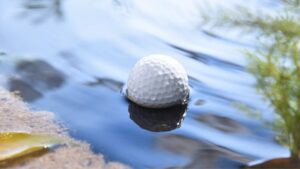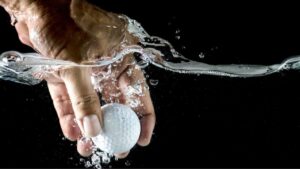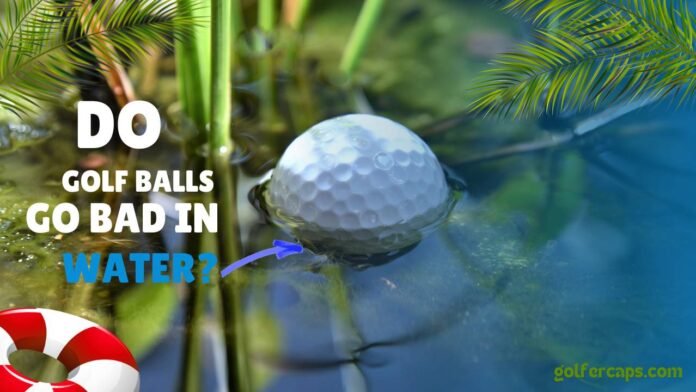Golf is a game of precision, where every aspect, from the swing to the equipment, can affect performance. Among the various pieces of equipment, the golf ball is a crucial component that can significantly impact your game. But what happens when your golf balls encounter water? Do they go bad, affecting your game? Let’s dive into the science behind golf ball deterioration in water and its implications for your game.
Factors Affecting Golf Ball Deterioration
When it comes to golf ball deterioration, several factors come into play. One significant factor is submersion in water. The longer a golf ball remains underwater, the greater the chances of deterioration. Additionally, environmental factors such as temperature and water quality can also influence how quickly a golf ball degrades.
Do Golf Balls Go Bad in Water?

The effect of water on golf balls is a bit debated. Here’s the breakdown:
-
Water absorption: Golf balls can absorb water, especially over time. This can happen even if the ball isn’t fully submerged. Some sources say this absorption can occur in as little as 6 hours.
-
Performance impact: There’s no consensus on how much water absorption affects performance. Some golfers believe it ruins the ball, while studies haven’t shown a significant difference between new balls and balls submerged for months.
-
Overall: Water might not render a ball unplayable immediately, but it’s best to avoid using balls that have been in the water for a long time, especially if you’re a serious golfer.
So, while they might not technically go “bad,” their performance can be affected. If you’re unsure about a ball, it’s always best to err on the side of caution and use a new one.
Can you play golf balls that have been in water?

You technically can play with golf balls that have been in the water, but there are some things to consider:
-
Performance Impact: Waterlogged balls can absorb water, making the core firmer and affecting distance and spin. This might not be a huge deal for casual play, but serious golfers will notice a difference.
-
Unpredictability: It’s hard to tell exactly how much water a ball has absorbed and how it will affect your shot. You might get inconsistent results.
-
Course Rules: Some courses have local rules against using water-retrieved balls during competition. Check the course rules before using them.
Here’s a breakdown of when it might be okay to use a ball that’s been in water:
- Just fished out: If you retrieved the ball yourself and it wasn’t submerged for long, it might be fine.
- Casual play: If you’re not too concerned about scoring and just having fun, a waterlogged ball might not be a big deal.
However, in these situations, it’s generally recommended to use a new ball for better performance and consistency:
- Serious play: If you’re playing competitively or want the best results, stick to new balls.
- Uncertain exposure: If you’re unsure how long the ball was in the water, play it safe with a new one.
Ultimately, the decision depends on your priorities and the situation.
how do tell if a golf ball is waterlogged?

Here are some ways to tell if a golf ball might be waterlogged:
Visual Inspection:
- Color: Look for a slight yellowing or discoloration compared to a new ball. Very discolored balls, or those with greenish/brownish hues, might have mold and should be discarded.
- Cover: Check for minor cracks, cuts or paint flaking on the outer shell. Damaged balls are more prone to water absorption.
- Logos: Faded logos can indicate a generally older ball that might have been exposed to water for longer.
Sound Test:
- Hitting: A waterlogged ball will often produce a dull thud when struck with a club, compared to the sharp crack of a dry ball.
Touch Test (not always reliable):
- Feel: Some golfers say waterlogged balls feel slightly heavier or softer than new ones. However, this method isn’t very precise.
Overall Condition:
- Consider how long the ball might have been exposed to water. If it was fished out of a pond after a few hours, it’s probably okay. But a ball that’s been submerged for days or weeks is likely affected.
Remember: If you’re unsure or serious about your game, it’s always better to play with a new ball.
How Long Do Golf Balls Last in Water?

The exact length of time a golf ball can stay in water before it’s unplayable is debatable. Here’s what we know:
- Water absorption: Studies suggest balls can absorb water in as little as 6 hours, though this might not significantly affect performance immediately.
- Performance impact: There’s no definitive answer on how much water absorption ruins a ball. Some golfers believe it significantly impacts performance, while studies haven’t shown a major difference between new balls and balls submerged for months.
Here’s a breakdown of what to consider:
- Ball quality: Premium balls with tighter seals might resist water absorption better than lower-quality ones.
- Water conditions: Stagnant or dirty water could accelerate waterlogging compared to clean, clear water.
- Damage: Existing cuts or cracks on the ball’s cover will allow water in faster.
Despite the lack of a clear timeframe, some golfers recommend discarding balls that have been submerged for:
- Short-term: As a precaution, some avoid using water-retrieved balls after just a few hours.
- Long-term: Balls left in water for days or weeks are more likely to be significantly affected.
Ultimately, the decision depends on your priorities:
- Serious play: If you prioritize performance, it’s best to avoid water-retrieved balls altogether.
- Casual play: For casual play, a ball that’s been in the water for a short time might be okay, but performance might be affected.
If you’re unsure about a ball, it’s always best to err on the side of caution and use a new one.
Read also: Do Golf Balls Expire?
Understanding Golf Ball Composition
Golf balls may seem like simple spheres, but their construction involves a sophisticated blend of materials carefully engineered to optimize performance. Understanding the composition of golf balls is crucial for players looking to improve their game and make informed choices when selecting equipment.
Core Materials
At the heart of every golf ball lies its core, which serves as the foundation for its performance characteristics. Cores are typically made from various materials, each offering unique properties that affect distance, spin, and feel.
- Rubber Cores: Traditional golf balls often feature solid rubber cores. These cores provide a firm feel and generate high levels of energy transfer upon impact, resulting in greater distance off the tee.
- Liquid-Filled Cores: Some modern golf balls utilize liquid-filled cores, often consisting of a mixture of water and other substances. These cores can be tuned to achieve specific compression levels, optimizing performance for different swing speeds.
- Dual Cores: Dual-core designs incorporate multiple layers of varying materials, each contributing to different aspects of performance. By fine-tuning the interaction between these layers, manufacturers can create golf balls that offer a balance of distance and control.
Outer Cover
Surrounding the core is the outer cover, which plays a crucial role in determining the ball’s feel, spin, and durability. Golf ball covers are typically made from one of two materials: surlyn or urethane.
- Surlyn Covers: Surlyn covers are known for their durability and resilience. These covers provide excellent abrasion resistance, making them ideal for golfers who prioritize longevity and consistency in their ball flight.
- Urethane Covers: Urethane covers offer a softer feel and enhanced spin control compared to Surlyn. Golf balls with urethane covers are popular among skilled players seeking maximum performance around the greens, where precise control is essential.
Layer Construction
Many modern golf balls feature multi-layer constructions, with each layer serving a specific purpose in optimizing performance. By strategically varying the composition and thickness of these layers, manufacturers can fine-tune aspects such as spin, trajectory, and feel.
- Intermediate Layers: Between the core and the cover, intermediate layers provide additional structural support and help regulate the transfer of energy upon impact. These layers contribute to the overall feel and responsiveness of the ball.
- Mantle Layers: Mantle layers sit between the core and the cover, acting as a transitional zone that influences the ball’s spin characteristics. By adjusting the composition and thickness of the mantle layers, manufacturers can tailor the ball’s performance to suit different player preferences.
Read also: How many dimples in a golf ball
Effects of Water on Golf Balls
When golf balls are submerged in water, they undergo several changes that can affect their performance on the course. One of the primary effects is water absorption, which can cause the ball to become heavier and alter its aerodynamic properties. Additionally, prolonged exposure to water can lead to the degradation of the core materials, further impacting the ball’s performance.
Tips for Preserving Golf Balls in Water

Encountering water hazards on the golf course is inevitable, but knowing how to preserve your golf balls when they get wet can help maintain their performance and prolong their lifespan. Here are some tips to help you preserve your golf balls in water:
1. Retrieve Quickly
Whenever possible, retrieve your golf ball from the water hazard as soon as it lands. The longer the ball remains submerged, the greater the risk of water absorption and deterioration.
2. Dry Thoroughly
After retrieving your golf ball from the water, dry it thoroughly using a towel or cloth. Removing excess moisture from the ball’s surface can help prevent water from seeping into the core and affecting its performance.
3. Store Properly
Store your golf balls in a dry, ventilated area when not in use. Avoid leaving them in damp environments or areas prone to moisture buildup, as this can accelerate deterioration over time.
4. Use Waterproof Accessories
Consider using waterproof accessories such as golf ball retrievers and bags to minimize the risk of your balls ending up in water hazards. These accessories can help you retrieve balls more easily and protect them from prolonged exposure to moisture.
5. Clean Regularly
Regularly clean your golf balls to remove dirt, debris, and contaminants that can affect their performance. Use a mild soap and water solution to gently scrub the surface of the balls, then rinse and dry them thoroughly before storage.
6. Rotate Inventory
If you have multiple sets of golf balls, rotate your inventory regularly to prevent any single set from being exposed to water for extended periods. Using a rotation system can help distribute wear and tear more evenly among your balls.
7. Inspect for Damage
Periodically inspect your golf balls for signs of damage or deterioration, such as discoloration, warping, or loss of elasticity. Discard any balls that show significant signs of water damage to prevent them from affecting your game.
8. Invest in Quality
Consider investing in high-quality golf balls with durable outer covers and water-resistant constructions. While they may be more expensive upfront, these balls are designed to withstand the rigors of the game and maintain their performance even when exposed to water.
Read also: How to Mark a Golf Ball?
Does Water Deterioration Affect Performance?
The deterioration of golf balls due to water exposure can indeed impact their performance on the course. Waterlogged balls tend to fly shorter distances and may have reduced accuracy compared to dry balls. Furthermore, the altered aerodynamic properties of water-damaged balls can affect spin rates, leading to unpredictable ball flight.
Cost Considerations
Replacing water-damaged golf balls can quickly add up, especially for avid golfers who frequently find themselves playing in wet conditions. Investing in high-quality, water-resistant golf balls may initially seem more expensive but can save money in the long run by reducing the need for frequent replacements.
Environmental Impact
Beyond the financial implications, the disposal of water-damaged golf balls can also have environmental consequences. Many golf balls contain synthetic materials that can take hundreds of years to decompose in landfills. By adopting sustainable practices, such as recycling or repurposing old golf balls, players can minimize their environmental footprint.
Conclusion
In conclusion, golf balls can indeed go bad in water, leading to decreased performance on the course. Factors such as water absorption and core degradation can impact the ball’s flight characteristics and overall playability. However, by understanding the effects of water on golf balls and taking proactive measures to preserve their condition, players can maintain peak performance and minimize the need for frequent replacements.
FAQs:
- Can I still use golf balls that have been submerged in water?
- While you can technically still use water-damaged golf balls, their performance may be compromised. It’s best to replace them if you notice any significant deterioration.
- How can I tell if my golf balls have been damaged by water?
- Look for signs such as discoloration, a softer feel, or weight changes. If in doubt, it’s better to err on the side of caution and replace them.
- Are there any specific cleaning methods for water-damaged golf balls?
- Gentle cleaning with warm, soapy water and a soft cloth can help remove dirt and grime from water-damaged golf balls. Avoid harsh chemicals or abrasive materials that could further damage the ball’s surface.
- Do all golf balls deteriorate at the same rate in water?
- The rate of deterioration can vary depending on factors such as the ball’s composition, quality, and how long it’s been submerged. Generally, higher-quality balls tend to be more resistant to water damage.
- Are there any preventive measures to protect golf balls from water damage?
- Storing your golf balls in a dry place, such as a cool, ventilated area, can help prevent water damage. Additionally, using waterproof golf ball bags or covers can provide added protection when playing in wet conditions.



